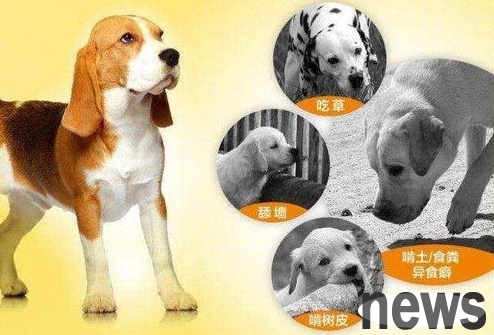I believe that dog owners who raise dogs have many strange things. Some chew on walls, some chew on sofas, and owners are also worried that dogs eating randomly will have an impact on their health. So what causes dog pica? Dog pica: A disease that c...
I believe that dog owners who raise dogs have many strange things. Some chew on walls, some chew on sofas, and owners are also worried that dogs eating randomly will have an impact on their health. So what causes dog pica?
Dog pica: A disease that causes dogs to lick or bite non-food or non-nutritional foreign objects due to environmental, genetic, nutrition, endocrine and other factors, and affects normal life.
Clinical manifestations
Depending on the characteristics of swallowing foreign bodies, whether they are retained in the digestive tract, or where they are retained, the clinical manifestations of pica are: licking, gnawing, swallowing food or litter contaminated by feces, hay, cinder, rags, etc.
Clinical research analysis, pica is not an independent disease, but a comprehensive disease that is affected by many such as chondrosis, indigestion, and chronic parasitic diseases.

Causes of pica formation
Environmental factors
1. The breeding density of dogs in groups is too large, the air circulation in the kennel is insufficient, the light time and light color are uncomfortable, and the dog is in a bad mood, depression and irritability.
2. Dogs lack the care of their owners. In order to resolve loneliness, dogs will become curious about foreign objects around them and even their own feces. If the owner does not stop it in time, these behaviors will form pica.
Nutritional factors
1. Improper diet leads to lack of trace elements, or pica caused by poor stomach and indigestion.
2. The lack of certain proteins and amino acids leads to metabolic dysfunction in the dog's body and symptoms of heteroemetic diet.
3. Deficiencies of other nutrient elements, such as calcium, magnesium, phosphorus, sulfur, iron, sodium, copper, cobalt, manganese and other minerals, especially the deficiency of sodium salts.
4. Deficiencies of certain vitamins and trace elements, especially B vitamins.
Disease factors
1. Toxins or stimuli produced by ectopic parasites can trigger pica.
2. Parasites in the intestine cause the digestive and absorption function of the intestine to decrease, resulting in insufficient nutritional elements in dogs and pica.
3. There are also some endocrine diseases that can also cause stress and cause pica.
Natural instinct
Dogs are playful, active, and curious, especially newborn puppies. They are curious about all kinds of things in the environment and will explore unfamiliar things around them through their mouths. If this behavior is not corrected in time, it will also form pica.
For example: Dogs eat feces, which is actually a dog's nature. If you do not pay attention to guidance, provide sufficient food or have good training, you will eat feces. You will not only eat your own feces, but also eat other animals' excrement. Therefore, once the clue is discovered, the owner should prevent training in time to avoid becoming a pica.

The harm of pica
1. Licking sharp foreign objects can damage the mouth.
2. Ingestion of foreign bodies can cause obstruction or perforation of the esophagus, stomach, and intestinal intestinal obstruction or perforation.
3. Licking the hair on the quilt, forming a hair ball in the stomach that is difficult to digest and excrete. When there are foreign objects in the digestive tract, the dog will have symptoms such as anorexia, hunger strike, and vomiting, which will affect the dog's health.
4. If you eat excrement from other animals, you are prone to infection and spreading diseases.
5. Pica dogs are prone to panic and are slow to respond to external stimuli; their skin is rough and dull, arched waist, teeth grinding, anemia, constipation and diarrhea alternately, and gradually lose weight, and severe cases are systemic failure and death.
Punishment and treatment of pica
If a dog has pica, you must have confidence in it, not dislike it, and care more about it, try to correct their bad eating behaviors in life and help it improve.
Balanced Diet Structure
1. Choose good dog food: high-quality dog food, balanced nutrition, moderate softness, good palatability, and easy to digest.
2. The nutritional needs of dogs are different from those of humans. They do not need to supplement carbohydrates and vitamin C. The bacteria in the dog's stomach can produce enough vitamin C. Feeding additional food to humans may also undermine your own nutritional balance.
Good eating habits
1. Good habits of regular, quantitative and fixed feeding can enhance appetite and help digestion.
2. Eliminate rotten and spoiled dog food. The taste of dog food can be changed according to the situation.
3. Appropriately provide animal protein foods such as meat, fat, and liver. You can also chop celery, rapeseed, etc. and cook it with the meat to improve the food for the dog. It is best to squeeze carrots into juice. They are mixed with other foods and their nutrition will not be lost.
Correct bad behaviors
1. Develop good excretion habits, especially during the development period of dogs, guide them to excrete in a fixed place, and remove feces in a timely manner.
2. If you find licking feces, punish and complain immediately. If you don’t clean up the feces immediately, if you find that you still lick them, you will punish them again, so that the dog will realize the consequences of this behavior and gradually quit bad habits.
3. If you find that your dog no longer licks the poop, you can use comfort and snacks to give praise and rewards to consolidate good habits.
4. When a dog appears to eat grass, it must also be severely scolded, slap the tip of his nose to warn, or hide in a hidden place and spray it with a water gun, and repeat it several times to achieve the purpose of training and correction.
5. Observe things that dogs are disgusting and sprinkle irritating substances such as chili powder. The dog feels uncomfortable, which is helpful to prevent it from trying again.
Regular deworming
parasitics can cause metabolic dysfunction and symptoms of heteroepitality. Parasites not only affect the growth of dogs but also pose a threat to humans. It is necessary to deworm regularly. The deworming time and method can be carried out according to the product instructions or as directed by the doctor.
Conclusion
Not all eating habits are pica. For puppies, because of curiosity, they are inevitably interested in things that are not food. As long as you can correct and guide in time, pica can be avoided.
Create a comfortable and pleasant living environment for dogs with pica to minimize stress. Adjust the nutritional structure of the diet, supplement trace elements, minerals and multiple vitamins in moderation, deworm them regularly, and inoculate them on time.
In life, spending more time with dogs and caring for dogs has a positive effect on preventing pica. Dog health is a happy thing.